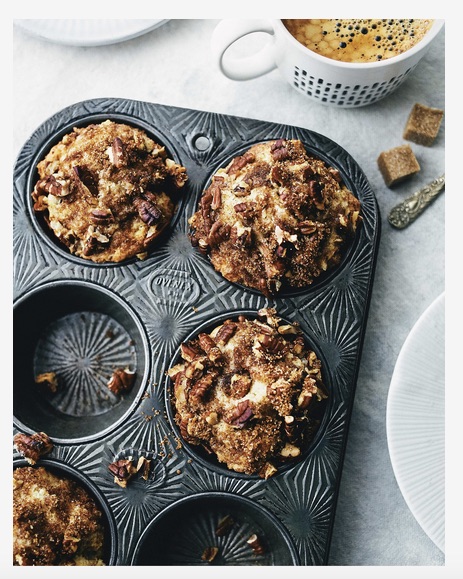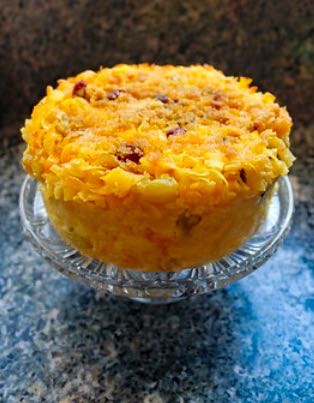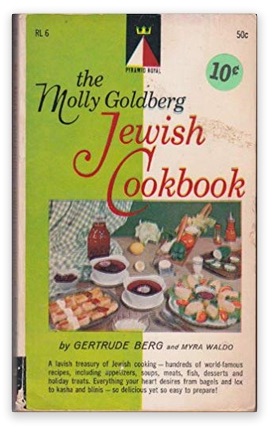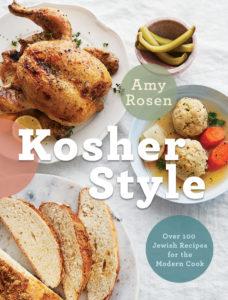Shabbat Shalom! The days are getting shorter and colder and sadly winter is on its way, perhaps sooner than later. As I write this week’s blog post, I can see the snow falling in my backyard. It’s definitely time to get the winter gear in order – hats, mitts, boots and snow tires. I already got a reminder from my mechanic.
As the season changes, we need to eat warming foods like stick-to-your-ribs Ashkenazi -style soups and kugels.
The recipes this week come from two vintage kosher cookbooks as well as two very modern Jewish cookbooks that were just published this fall.
I found the Vegetable Soup recipe in The Molly Goldberg Jewish Cookbook by Gertrude Berg and Myra Waldo. This book was originally published in 1955 and went through seven printings.
The recipe for Gehackta Beef di Mama Mia is from The Italian Kosher Cookbook (circa 1964) by Ruth and Bob Grossman.
Cookbook author and food columnist, Amy Rosen, will be doing a cooking demo at Nosh Fest on Dec. 1. She has kindly provided her recipe for Sour Cream Pecan Coffee Cake Muffins from her new book, Kosher Style: Over 100 Jewish Recipes for the Modern Cook.
Sharon Matten, a food writer and kosher food blogger from Chicago, just released her new book, Shabbos Under Pressure. Matten has created many traditional kosher recipes that can be prepared in the new modernized pressure cooker. She has sent her recipe for Fruity Noodle Kugel.
COOKBOOKS: OLD AND NEW
The Molly Goldberg Jewish Cookbook by Gertrude Berg and Myra Waldo
Last year I acquired some vintage kosher cookbooks. I enjoy looking at the old recipes and I love to see the dog-eared pages and the food stains in a well used book. Food maven Norene Gilletz gave me her spare copy of The Molly Goldberg Jewish Cookbook (hers is the 1968 edition). In fact, you can still buy second-hand copies of the book on Amazon.
Apparently Molly Goldberg was a role created by Gertrude Berg, the co-author of this cookbook. She played the character of Molly Goldberg in a sitcom called The Goldbergs, a popular radio show that started in the ’30s and continued on through the ’40s. The show later became a TV series that ran until the mid ’50s.
VEGETABLE SOUP (Gertrude Berg and Myra Waldo)
60 ml (4 tbsp) shortening**
2 onions, sliced
2 carrots, sliced
250 ml (1 cup) shredded cabbage
2 stalks celery
230 g (½ lb) green peas, shelled (or use frozen)
115 g (¼ lb) string beans, halved
115 g (¼ lb) lima beans, shelled
1 3/4 L (l7 cups) water (or vegetable stock)
10 ml (2 tsp) salt
1½ ml (¼ tsp) freshly ground black pepper
2½ ml (½ tsp) sugar
2 tomatoes, peeled and chopped
2 potatoes, peeled and diced
113 g (¼ lb) fine noodles, cooked and drained
15 ml (1 tbsp) chopped fresh parsley
**NB margarine, olive oil or canola oil can be substituted for shortening
Melt the shortening in a saucepan. Add the onions and sauté for 10 minutes, stirring frequently. Add the carrots, cabbage, celery, green peas, string beans, and lima beans. Cover and cook over low heat for 10 minutes. Add the broth, salt, pepper, sugar, tomatoes, and potatoes. Cover, and cook over medium heat for 30 minutes. Add noodles and parsley. Cook an additional 15 minutes.
THE ITALIAN KOSHER COOKBOOK by Ruth and Bob Grossman
My friend Lucy Somer loaned me this book. She said the Yiddishisms are a hoot, and some of the jokes are dated while others would be considered politically incorrect these days.
The Italian Kosher Cookbook is part of a larger volume called The Kosher Cookbook Trilogy, which also includes Chinese and French sections. Apparently Ruth Grossman’s grandmother had collected recipes for classic Chinese and French dishes as well as Italian ones. She also figured out how to make them kosher.
The Grossmans use humorous names for the various Italian dishes combining the Italian with Yiddish expressions. At the bottom of each page they give definition for the Yiddishism or they provide a Jewish joke. For instance, for Meat Sauce Mona Lisenbaum they say: “Mona Lisenbaum was the name of Mona Lisa before the family left Poland.”
There’s a dish called Ravioli Galitziana. The book’s definition for Galitziana is “the Jewish equivalent of a Sicilian.”
I chose a recipe called Gehackta Beef Di Mama Mia because it’s a hearty meat dish with a twist and it would appeal to my husband. He loves ground beef as well as salami.
As for the Grossmans’ definition of Mama Mia: “Her name is Giacobbi instead of Jacobs; she makes minestrone instead of chicken soup; and she cooks with olive oil instead of schmaltz.”
GEHACKTA BEEF DI MAMA MIA (Ruth and Bob Grossman)
450 g (1 lb) ground beef
6 thin strips pimento
6 slices salami, shredded
1 egg, beaten
few pinches of salt
few pinches of pepper
15 ml (1 tbsp) flour
60 ml (1/4 cup) olive oil
900 g (16 oz) tomato sauce
30 ml (2 tbsp) chopped parsley
5 ml (1 tsp) dry oregano
5 ml (1 tsp) dry garlic powder
5 ml (1 tsp) sugar
Spread the beef on a floured board and turn it into a rectangular shape about 2 cm (1/2 inch) thick.
Sprinkle the pimento and salami over the meat. Pour the egg on top of the salami and pimento. Add salt and pepper. Roll one edge of the meat toward the middle of the board and continue rolling to create a log, like a strudel. Dust the strudel with the flour.
In a large casserole dish or deep pot add the oil. On medium heat, brown the meat in the oil on all sides. Move the meat gently to prevent the log from falling apart.
Pour the tomato sauce into the pan and add the parsley, oregano, garlic powder and sugar.
Simmer the meat uncovered for half an hour. If the sauce gets too thick, thin it with water or wine.
Before serving, skim off the fat.
Makes 4 servings.
READ: ISRAELI FOOD HAS WORLDWIDE APPEAL
KOSHER STYLE: OVER 100 JEWISH RECIPES FOR THE MODERN COOK by Amy Rosen
Rosen said working on her fifth cookbook, Kosher Style, was literally a labour of love. “It’s a passion project I wanted to do for a decade after my Bubby and my Bubbe passed away.”
Rosen said many of the recipes in Kosher Style are based on her “taste memories” of her grandmothers’ cooking, but she has recreated those cherished recipes using fewer packaged goods. “I’m good at figuring things out.”
Rosen has essentially updated a host of classic traditional Jewish recipes. “Ashkenazi Jewish food is brown. It’s delicious, but not gorgeous. I’m trying to change that in this book,” she said, adding that she uses fresh ingredients in the recipes in order to modernize the taste and the look of those dishes.

SOUR CREAM PECAN COFFEE CAKE MUFFINS (Amy Rosen)
Topping:
250 ml (1 cup) finely chopped pecans, toasted
60 ml (¼ cup) packed brown sugar
30 ml (2 Tbsp) sugar
5 ml (1 tsp) ground cinnamon
Batter:
250 ml (1 cup) butter, softened
120 ml (½ cup) sugar
2 eggs
120 ml (½ cup) full fat sour cream
5 ml (1 tsp) vanilla extract
375 (1½) cups flour
5 ml (1tsp) baking powder
2½ ml (½ tsp) baking soda
2½ ml (½ tsp ) sea salt
Preheat the oven to 190°C (375°F) and line a 12-cup standard muffin tin with paper liners.
To make the topping: combine the pecans, both sugars and the cinnamon in a small bowl. Set aside.
For the batter, using a stand mixer, beat the butter with sugar until fluffy, about 3 to 4 minutes. Scrape down the sides and add the eggs, sour cream and vanilla.
Whisk together the flour, baking powder, baking soda and salt. Gradually beat the dry ingredients into the butter mixture, scraping down the sides occasionally and making sure that everything is combined and fluffy.
Spoon 15 ml (1 tbsp) of the batter into the bottom of each paper liner, then sprinkle each with 5 ml (1 tsp) of the pecan topping. Add another spoonful of batter to each liner, then sprinkle with the remaining topping.
Bake the muffins on the middle rack of the preheated oven for 20 to 22 minutes, or until a cake tester inserted in the centre of a muffin comes out clean. Store at room temperature in your best airtight container for up to 2 days.
SHABBOS UNDER PRESSURE by Sharon Matten
The pressure cooker has become the go-to kitchen appliance. It’s safer and more efficient than the old-style pressure cookers. They save time, conserve energy and they enhance flavour.
“Today’s Jewish home cooks want to feed their families with delicious, yet traditional recipes that are more contemporary and faster,” Matten says. “Today’s safer pressure cookers remove the fear of disaster and gives us a fabulous way to cook family meals quickly and easily.”
“If you can boil it, steam it, or braise it, you can pressure cook it!,” she says.
Matten has created recipes that work for every brand of electric pressure cooker, whether it’s an Instant Pot, Crock Pot, Express Cooker or any other brand of pressure cooker. Many of the dishes can also be prepared in a slow cooker.
The following recipe is reproduced with permission from the publisher, First Impression, November 2019.

FRUITY NOODLE KUGEL (Sharon Matten)
Nonstick vegetable spray
340 g (12 oz) wide egg noodles, uncooked
1 900 g (30 ounce) can fruit mix with cherries in syrup
1 560 g (20-ounce) can crushed pineapple, undrained
125 ml (½ cup) granulated sugar
125 ml (¼ cup) pure maple syrup
125 ml (¼ cup) canola oil
4 large eggs
125 ml (¼ cup) all-purpose flour
For Finishing
125 ml (¼ cup) light brown sugar
ADDED WATER
125 ml (½ cup)
Spray a 18 cm x 8 cm (7-inch x 3-inch) round pan and lid with non-stick, vegetable spray. Set aside.
Mix the egg noodles, canned fruit (with the liquid), crushed pineapple (with the liquid), sugar, maple syrup, canola oil and large eggs together in a large bowl. Fold in the flour.
Pour the mixture into the prepared pan. Cover with the tightly fitted lid.
Place a rack/trivet with handles on the bottom of the EPC (Electric Pressure Cooker) pot. Add the 125 ml (½ cup) water to the bottom. Carefully set the kugel on the rack. Lock the lid and close the pressure valve.
Cook for 10 minutes using manual high-pressure mode. Naturally release the pressure for 30 minutes, then manually release the pressure.
Remove the kugel from the EPC pot and remove the kugel pan lid.
For Finishing: Sprinkle the top of the kugel with the 60 ml (¼ cup) brown sugar.
Place the kugel in the centre of the oven and broil using medium heat for 5 to 7 minutes. The top of the kugel will turn a little brown and the sugar will become slightly bubbly. Serve warm or cold.
NOTES:
Removing the kugel: Taking this kugel out of the pan can be a little tricky. When the kugel has cooled, run a knife around the edge of the kugel to loosen. Place a dinner plate on top of the kugel. Place one hand under the kugel pan and one hand on top of the dinner plate. In one fluid motion, flip the kugel onto the dinner plate. To get the kugel on the serving plate, repeat with a serving plate upside down on top of the inverted kugel.
The added water is the water that is used to facilitate the pressurizing of the Electric Pressure Cooker. It is not part of the actual recipe.
Each brand of pressure cooker has its own method for setting the mode to manual high-pressure mode. Please see your EPC brand’s instruction manual for directions.
For more information about Sharon go to www.sharonmatten.com or follow her on Instagram @SharonMatten.
JEWISH FOOD EVENTS CALENDAR
Nov. 29 Let’s Do Brunch: Fundraiser to bring awareness to Crohn’s and Colitis
Dec. 1 NoshFest: Taking place at Artscape Wychwood Wood Barns
Dec 1-2 Ezer Mizion Toronto: Shuk Machane Yehuda Promenade Mall



